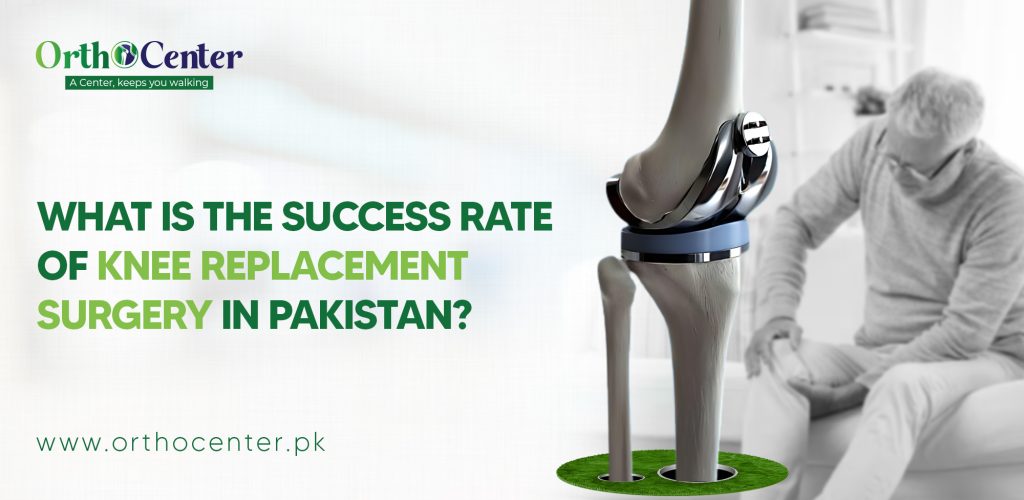Welcome to Our Orthopedic Clinic in Pakistan!

Nothing can be worse than to realize that you can’t move freely, even to do the little things you do every day. It can happen if your knees are not strong enough. These are the knees that enable you to walk, sit, climb steps and much more. Plus, they support your body weight, absorb shock(if any) and maintain body equilibrium. Diseases like arthritis, any injury or aging can make your joints weak, and you feel pain and an inability to move freely.
In case of severe joint damage, knee replacement surgery is considered a solution. The reason for its high approval is that it allows a new artificial part to replace the damaged one. The new components help to restore smoother movement. The prominent outcomes of the operation include getting rid of chronic pain, restoration of joint function and regaining of previously restricted mobility. Let us figure out the success rate of knee replacement surgery and the factors that can influence its outcomes.

It is the procedure that keeps patients hopeful even after damage to the entire knee joint. It may happen in case of advanced arthritis or injury. As is clear from the name, in TKR, the surgeon eliminates all the damaged cartilage and bone from the joint surfaces. The next step is to replace them with artificial components. This creates a smooth, pain-free surface, restores alignment, and helps the joint move more naturally. As the operation addresses the whole knee, patients can experience a lasting relief and dramatic shift in mobility.
Recommendation: Surgeons consider it for people with severe, widespread damage. Moreover, for older people, its suitability is high.
Contrary to total knee replacement, the focus of partial knee replacement is on preserving the healthy bone and ligaments. This is why surgeons remove and replace only a selective portion of the knee that is hurt. For instance, if arthritis has worn away only the inner side of the joint, the surgeon will replace just that compartment. Consequently, this sort of knee replacement is less invasive and often results in quicker recovery. Moreover, associated risks like blood loss are less and more natural knee function is often.
Recommendation: It’s only suitable for patients with damage limited to one area of the joint. Moreover, young people with the desire to have intense movements in future find it helpful because most of the natural joints remain safe.
With the other name, patellofemoral replacement, this option targets the underside of the kneecap and the groove it rests in. Since it leaves most of the knee intact, it is less invasive and can provide excellent results for carefully selected patients. Through this type, a surgeon can fix the injured area partially. As a result, pain reduces, mobility improves, while preserving much of the natural knee structure.
Recommendation: It is recommended when arthritis or damage is confined to the front of the knee.
Various factors, such as ageing or different lifestyle routines, are common reasons for trouble causing knee pain. Moreover, numerous medical conditions such as osteoarthritis or injury can damage knee health. Usually, the use of medication or therapies remains ineffective in case of an injured knee. Hence, knee replacement surgery is a surgical method to replace the affected part of the knee with artificial implants, allowing patients to resume convenient movement. In addition to pain relief, surgical upshots include the removal of knee stiffness and hindrance to bending.
Surgical treatment options are complex and time-consuming. Moreover, it is often costly compared to other methods. Knee replacement costs vary based on factors such as hospital fees, surgeon expertise, and implant type. Hence, people usually pick surgeries as a last choice and seem conscious about the success. Although statistics prove that the success rate of knee replacement surgery lies between 80 to 95 percent, it may vary depending on various factors, including the overall expense and quality of care received. Here are some crucial factors:
Nothing comes before your health. A skilful and experienced orthopedic surgeon is the leading artist who has to portray your health picture. Hence, choosing the right orthopedic to hand over your future health is crucial. It will determine the efficacy of the surgical method and its outcomes, thus determining the success level. For this purpose, you can take the opinion of medical-related friends and search for the best orthopedic by analyzing the reviews and history of successful surgeries.
Clinical facilities do not only consist of room conditions. It includes the condition and model of equipment and tools and the status of available intensive care options. Hence, for a successful surgery, it is crucial to take into account all these facilities. The use of the latest technologies guarantees an upgraded success rate of knee replacement.
The replaced artificial implant is the thing you have to live with for the rest of your life. Hence, its quality is an uncompromisable part of surgery. Therefore, be sure about the use of high-quality implants to enjoy the long-term benefits of surgery making it highly successful.
Pre-surgical consultation helps to understand the current knee condition and overall health status. It results in setting achievable goals and understanding potential complications and necessary adaptations before surgery. Altogether, these factors help to avoid mental stress and to acknowledge the remedies to deal with problematic situations. Hence, this results in the overall goal of achieving surgery.
The patient’s health status, such as weight, existence of other medical conditions and physical strength, affects the surgical upshots. In addition, the age factor is also noteworthy. Hence, goal achievement for knee replacement may vary from person to person according to his overall health and age. Therefore, the success level also fluctuates.
An accurate execution of surgery is not the last thing that announces it is successful. Taking care after surgery is as significant as its keen and skillful processing. Postoperative care includes proper implementation of the surgeon’s instructions, such as medication and diet, and the reintroduction of physical activities. Moreover, wound care is crucial to prevent infection or any other medical issue. Furthermore, physical therapy may be needed for better recovery.
Depending on the type of knee replacement, short- or long-term lifestyle modifications are vital. Your surgeon may ask you to use any bracelet or to use a clutch for a few days. Some longstanding requirements may include healthy weight management or permanently avoiding specific movements. Adaptation of these changes reduces the risk of complications or recurrence of problems leading to a successful surgery.
Although regular follow-ups will cost you and also be time-consuming, they provide you with considerable benefits in terms of persistent knee health. Hence, to retain fruitful outcomes for an extended period, stay in touch with your surgeon to monitor the health of the joint and instantly resolve the issues, if any.
Any individual needs a lot of patience to successfully come out of the rehabilitation period. It is so because recovery following a knee replacement is gradual. Each stage lays the foundation to regain strength, comfort, and independence; therefore, it is essential to comprehend what will happen during this phase.
Everyone after surgery feels weak physically and emotionally. To avoid the impact of this weakness on your health, you have to focus on healing and start gentle movements. Doctors keep you in the hospital for a few days to help you manage pain with medication and to closely watch for complications. You may receive support for compression devices or ice packs that will reduce swelling.
It is crucial to start moving within 24 hours after knee replacement surgery. Even taking a few steps with the help of a walker or crutches matters. Further, a physiotherapist guides simple exercises to keep blood flowing, prevent stiffness, and start rebuilding strength. Though this stage can feel uncomfortable, early movement complements a smoother recovery and helps patients regain independence sooner.
Every patient must be mentally ready to face the possible challenges after a knee replacement. Here are some challenges and their solutions that folks usually face.
| Knee Replacement Type | Success Rate | Longevity |
|---|---|---|
| Total Knee Replacement | 90-95% | 15-20 years |
| Partial Knee Replacement | Over 90% | 10-15 years |
| Knee Resurfacing | 85-90% | 10-15 years |
In closing arguments, Knee replacement surgery is a high-impact operation that enables folks to restore their mobility. It can address most of the knee joint problems caused by diseases, injuries or age factors. The good thing, despite being a complicated procedure with a slower recovery, it comes with a notable success rate. The general experience of patients is to enjoy the results for a period of 10 to 20 years or more, depending on the type of replacement. Moreover, the quality of implants also determines the percentage of success as well as longevity.
Dr Ahmed Shoaib at Orthocenter is a well-rounded surgeon with a strong educational background in the field. The procedures at the clinic are of international standards with an exceptional level of patient care. In addition to other elements, the competency of a surgeon can change your journey to be active again.
Find the top orthopedic clinic in Pakistan for comprehensive care. Expert treatments for bone, joint & muscle issues. Visit us for trusted solutions.
Ortho Center All Rights Reserved © 2025 Designed, Developed & Marketed by Marketing Agency for Orthopedic Surgeon
WhatsApp Us